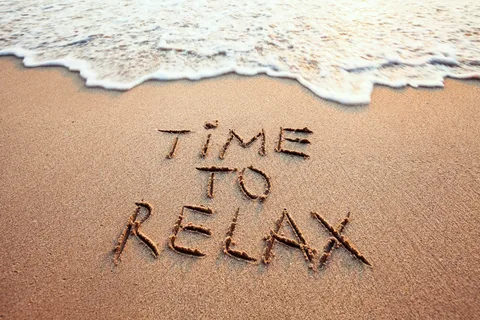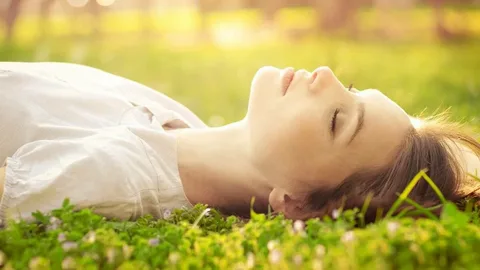Table of Contents
ToggleIntroduction
In our fast-paced modern world, stress has become an unwelcome daily visitor for many. In the constant race against time, finding moments of tranquility can seem like an insurmountable challenge. This article, “Rest and Relaxation Techniques: Oasis of Calm”, aims to help you navigate through this maze of stress. It introduces you to a variety of effective techniques to help you find your oasis of calm amidst the chaos. From traditional methods like meditation and yoga to modern relaxation practices, this guide is intended to help you reclaim your inner peace and enhance your overall well-being. So, take a deep breath and begin your journey towards a calmer, more centered you.

Rest and Relaxation
Rest and relaxation, often abbreviated as R&R, refers to the time spent in recuperation and leisure, away from the pressures and demands of daily life. It involves activities or practices that allow the body and mind to take a break from exertion and stress, fostering physical, mental, and emotional recovery. This can include sleep, meditation, leisurely walks, reading, or simply sitting in silence—anything that helps to reduce tension and promote a state of calm.
Importance of Incorporating Restful Techniques
Incorporating restful techniques into your daily routine is essential for maintaining optimal health and well-being. Regular periods of relaxation not only rejuvenate the body and mind but also improve productivity, boost mood, enhance creativity, and lower the risk of chronic diseases. By teaching us to slow down, restful techniques help foster a healthier relationship with stress, enhancing our resilience, and promoting a better quality of life.
Connection Between Rest and Relaxation
The concepts of rest and relaxation, though distinct, are deeply interconnected, forming a crucial part of our overall well-being. Rest refers to the state of ceasing work or movement to rejuvenate the body and mind. On the other hand, relaxation, often seen as an active process, involves engaging in activities or practices that help reduce tension and promote a state of calm.
When integrated, rest and relaxation create a harmonious blend, enhancing the body’s natural healing process, lowering stress, and contributing to improved physical health and emotional balance. Thus, incorporating a balance of both rest and relaxation into our daily routine is pivotal to maintaining a healthy life.
The Science Behind Rest and Relaxation
Neurological Impact
Rest and relaxation significantly impact our neurological health. When we rest, the brain enters a state called the default mode network, where it actively consolidates memories, supports learning, and facilitates problem-solving. During deep relaxation, such as in meditation, our brain wave patterns shift from the high-frequency waves of our active states (beta waves) to slower alpha waves, often resulting in increased creativity and decreased anxiety.
Role of Neurotransmitters in Creating a Calm State
Neurotransmitter activity plays a key role in creating a calm state. During relaxation, the brain increases the production of neurotransmitters such as serotonin and dopamine, which are associated with feelings of well-being and happiness, and reduces the release of stress hormones like cortisol. This shift in chemical balance helps promote a state of calm, improve mood, and enhance overall mental well-being.
Physiological Benefits
One of the major physiological benefits of rest and relaxation is its positive impact on heart health. When we engage in relaxation activities, our heart rate slows down, blood pressure reduces, and the demand for oxygen decreases. This lessens the overall strain on the heart, reducing the risk of cardiovascular diseases in the long run.
Reduction of Stress Hormones
Relaxation techniques also assist in reducing the levels of stress hormones in the body. During periods of stress, the body releases hormones such as cortisol and adrenaline. While these hormones are beneficial in short bursts, prolonged exposure can lead to damaging effects, such as inflammation, weight gain, and heart disease. Regularly practicing relaxation techniques can help in maintaining a balance of these hormones, thereby mitigating the adverse effects of stress.
Boosting the Immune System through Rest and Relaxation
Rest and relaxation also play a crucial role in boosting our immune system. Chronic stress can suppress the immune response, making us more susceptible to infections and diseases. However, activities that promote relaxation, such as meditation and deep breathing, can counteract these effects by reducing stress levels and enhancing the body’s natural ability to fight off pathogens.
Types of Rest and Relaxation Techniques
Mindfulness Meditation
Mindfulness Meditation is a technique that trains your mind to focus on the present moment, embracing an attitude of acceptance, curiosity, and openness. It encourages a heightened awareness of your feelings, thoughts, and experiences, without judgment or distraction.
How to Practice Mindfulness
Find a quiet and comfortable space. Choose a place where you won’t be disturbed during your meditation practice.
Adopt a comfortable posture. You can sit on a cushion, chair, or even lie down. Ensure your back is straight but not rigid.
Focus on your breath. Close your eyes and bring your attention to the act of breathing. Notice the sensation of air entering and leaving your body.
Acknowledge your thoughts. When you notice your mind wandering, gently bring it back to your breath. The goal is not to suppress thoughts but to acknowledge them without judgment and let them go.
Practice regularly. Consistency is key to reaping the benefits of mindfulness. Aim to practice for a few minutes every day, gradually extending the duration over time.
Scientifically Proven Benefits
Mindfulness meditation has been extensively studied and found to offer numerous benefits:
Improves mental health: Studies show that mindfulness meditation can help reduce symptoms of anxiety and depression and improve overall psychological well-being.
Enhances attention and concentration: Regular practice of mindfulness has been found to enhance cognitive functions, particularly attention span and focus.
Alleviates stress: Mindfulness meditation can significantly decrease stress levels by altering the body’s response to stress.
Promotes emotional stability: By promoting an attitude of acceptance and non-judgment, mindfulness can improve emotional regulation, leading to healthier relationships and better quality of life.
Improves physical health: The stress-reducing benefits of mindfulness can lead to improved physical health in various ways, from lowering blood pressure to boosting immune system function.
Progressive Muscle Relaxation
Progressive Muscle Relaxation (PMR) is a technique that helps reduce stress and anxiety by systematically tensing and then relaxing each muscle group in the body. This practice not only promotes a deep state of relaxation but also enables individuals to become more aware of physical sensations, thereby promoting a better mind-body connection.

Step-by-Step Guide to PMR
Find a quiet and comfortable place. Sit or lie down in a position where your body can fully relax.
Begin with a few deep breaths. Inhale deeply, hold for a few seconds, and then exhale slowly. Repeat this a few times to help your body relax.
Tense and relax each muscle group. Start with your feet and work your way up to your face. As you focus on each muscle group, tense it as hard as you can (without causing pain) for about 5 seconds, and then release the tension and relax for about 30 seconds before moving on to the next muscle group.
Notice the contrast. Pay close attention to the difference between the sensations of tension and relaxation in your muscles. This will help you become more aware of physical stress and tension in your body.
Practice mindfulness. As with mindfulness meditation, if your mind begins to wander, gently bring your focus back to the muscle you are working on.
Applicability for Stress Reduction
PMR is particularly beneficial for stress reduction. By deliberately inducing relaxation in the body, we can counteract the body’s stress response, reduce cortisol levels, and promote a state of calm. This technique is also useful in managing symptoms of conditions exacerbated by stress, such as insomnia, chronic pain, and digestive issues. Regular practice of PMR can significantly improve your ability to cope with stress and enhance overall well-being.
Breathing Exercises
Breathing exercises form a critical part of rest and relaxation techniques. They are simple yet powerful tools that can effectively reduce stress, alleviate anxiety, and promote overall well-being.
Importance of Breath in Relaxation
Our breath is a reflection of our emotional states and thoughts. When we are stressed or anxious, breathing becomes rapid and shallow. Conversely, when we are relaxed, our breath is slow and deep. By consciously regulating our breath, we can influence our emotional state and induce relaxation. Taking slow, deep breaths sends signals to our brain to calm down and relax, thereby reducing stress and promoting a sense of calm and well-being.
Techniques for Deep Breathing
Diaphragmatic breathing: Also known as belly breathing, this technique involves inhaling deeply into your diaphragm rather than shallowly into your chest. To practice, sit or lie down in a comfortable position. Place one hand on your chest and the other on your belly. Take a slow, deep breath through your nose, allowing your belly to rise as it fills with air. Exhale slowly through your mouth or nose, letting your belly fall. The hand on your chest should stay relatively still.
Box breathing: This technique involves taking slow, deep breaths while mentally visualizing a box. Inhale for a count of four, hold your breath for a count of four, exhale for a count of four, and then wait for a count of four before taking another breath. This method can help to slow your heart rate and reduce stress.
4-7-8 breathing technique: This technique is a simple yet powerful relaxation tool. Inhale quietly through your nose to a mental count of four. Hold your breath for a count of seven. Exhale completely through your mouth, making a whoosh sound to a count of eight. This completes one breath. Now inhale again and repeat the cycle three more times for a total of four breaths.
Sleep Hygiene
Sleep hygiene refers to the practices and habits that one can adopt to improve the quality and quantity of sleep. A good sleep routine can contribute to mental well-being and productivity. Just like a healthy diet and regular exercise, adequate sleep is crucial for overall health and vitality.
Creating a Relaxing Sleep Environment
Creating a conducive environment for sleep can greatly enhance the quality of your rest. Here are a few suggestions:
Darkness: Light can interfere with your circadian rhythm – your body’s internal clock that regulates sleep and wakefulness. Ensure your bedroom is sufficiently dark, using curtains or an eye mask if necessary.
Comfort: Invest in a quality mattress and pillows that offer good support. The comfort of your bed can significantly affect your sleep quality.
Temperature: Keep your bedroom at a comfortable temperature, ideally between 60 to 67 degrees Fahrenheit.
Noise: Minimize noise as much as possible. If you cannot control external noise, consider using earplugs or a white noise machine.
Tips for Improving Sleep Quality
Consistent sleep schedule: Try to go to bed and wake up at the same time every day, including weekends. This can help regulate your body’s internal clock and enhance sleep quality.
Limit daytime naps: Long daytime naps can interfere with night-time sleep. If you must nap, limit yourself to about 20-30 minutes and make it during the mid-afternoon.
Exercise: Regular physical activity can help you fall asleep faster and enjoy deeper sleep. However, don’t exercise too close to bedtime as it might interfere with your sleep.
Avoid caffeine and heavy meals at night: Both can disrupt your ability to fall asleep.
Relaxation techniques: Practices like meditation, deep breathing or progressive muscle relaxation can help you wind down before bed and improve your sleep quality.
Nature Therapy
Nature Therapy, also known as ecotherapy or green therapy, advocates for a strong connection with the natural world to boost mental and physical well-being. It is grounded in the understanding that people are part of the web of life and that our psyches are deeply connected to, and influenced by the natural world.
Benefits of Connecting with Nature
Connecting with nature has a myriad of health benefits. Research suggests that it can reduce feelings of stress, anxiety, and depression, increase happiness, and improve cognitive function. Exposure to nature has also been linked to lower blood pressure and improved immune function. The soothing sights and sounds of nature can help to calm the mind and promote a sense of peace and tranquility. Moreover, activities in nature such as hiking, gardening, or bird-watching can provide an opportunity for physical exercise, further enhancing overall health and well-being.
Incorporating Nature into Daily Life
Incorporating nature into daily life doesn’t necessarily require significant changes. Start by spending more time outside each day, whether it’s having lunch in a park, walking or cycling to work instead of driving, or simply sitting in a garden. If you live in an urban area, indoor plants can bring nature into your home and improve air quality. Engaging in outdoor hobbies like photography, painting, or bird-watching can also help you to connect with nature. Even simply opening a window to let in fresh air and natural light can have a positive impact. In essence, it’s about finding ways to engage with the natural world in a manner that resonates with you.

Oasis of Calm in Different Lifestyles
In our fast-paced, digital world, finding an oasis of calm within different lifestyles can be a challenge. However, it is not impossible. Whether you lead a bustling city life, a suburban family existence, or a remote rural lifestyle, there are ways to create pockets of peace and tranquility.
City Lifestyle: Amid the hustle and bustle, it’s crucial to carve out quiet moments for yourself. This could be as simple as visiting a local park, practicing mindfulness during your commute, or creating a serene space in your home.
Suburban Lifestyle: With a bit more flexibility and proximity to nature, suburban dwellers might consider cultivating a garden, or taking walks or bike rides around the neighborhood. Additionally, mindful activities like yoga or meditation can be practiced in the comfort of your home.
Rural Lifestyle: Those living in rural areas can take advantage of the inherent tranquility. It’s beneficial to spend time outdoors, whether farming, hiking or simply sitting in nature. However, even in this quiet environment, it’s important to cultivate mindfulness and present moment awareness.
Across all lifestyles, remember to disconnect from digital devices regularly, practice deep breathing, maintain good sleep hygiene, and connect with nature as much as possible. These practices can help you find your oasis of calm within your specific lifestyle. This oasis of calm is not a physical space, but a state of mind that can be accessed regardless of external circumstances.
FAQs
What are some relaxation techniques I can use before bedtime?
There are several relaxation techniques you can use to prepare your body for sleep. These include deep breathing exercises, progressive muscle relaxation, visualization, meditation, and yoga. Listening to calming music or nature sounds can also help.
How long should I exercise to improve my sleep?
Generally, 30 minutes of moderate exercise, such as brisk walking, 3-4 times a week can help improve sleep. However, the ideal duration and intensity may vary from person to person. Remember to avoid rigorous workouts close to bedtime as it might interfere with your sleep.
How can I incorporate nature into my daily routine if I live in a city?
Even in a city, there are ways to connect with nature. Visit city parks, cultivate indoor plants, or engage in nature-inspired hobbies like bird-watching or photography. Even a simple walk in a green area during your lunch break can make a difference.
Conclusion
The journey towards rest, relaxation, and finding your oasis of calm is a personal and unique one. It involves an intermingling of various techniques such as maintaining a consistent sleep schedule, limiting daytime naps, exercising regularly, avoiding caffeine and heavy meals at night, and incorporating relaxation techniques. Additionally, nurturing a connection with nature – whether you live in a city, suburb, or rural area – can offer immense benefits for mental and physical well-being. Remember, the ultimate goal is not just about achieving restful sleep, but about cultivating a lifestyle that promotes overall calm and well-being.




















